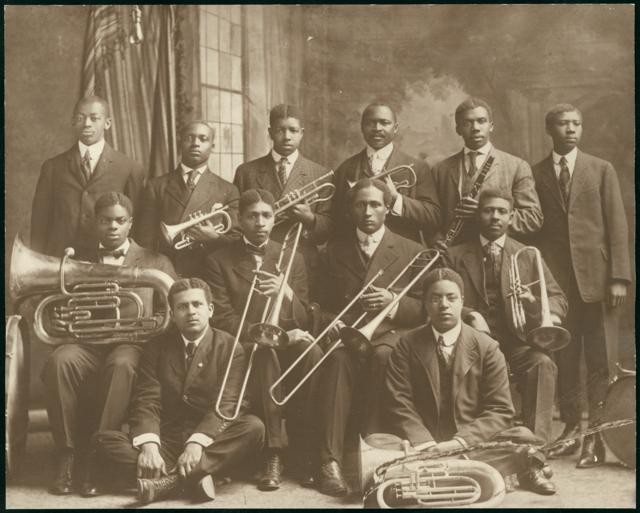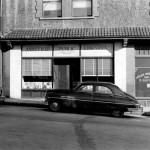- The Young Men's Institute Band specialized in classical and jazz. Dr. William J. Trent, seated on the floor left, was on the first YMI board of directors and went on to become president of Livingstone College in Salisbury, N.C. Photo from the NC Collection, Pack Memorial Library, Asheville, N.C.
- Pictured here in 1953, the Market Street Branch Library (called “the colored library” when it opened on Market Street in 1927) was housed in the YMI building. It remained in operation until 1966, when the library system desegregated. Photo from the N.C. Collection, Pack Memorial Library, Asheville, N.C.
*The Young Men's Institute Band specialized in classical and jazz. Dr. William J. Trent, seated on the floor left, was on the first YMI board of directors and went on to become president of Livingstone College in Salisbury, N.C. Photo from the NC Collection, Pack Memorial Library, Asheville, N.C.
*Pictured here in 1953, the Market Street Branch Library (called “the colored library” when it opened on Market Street in 1927) was housed in the YMI building. It remained in operation until 1966, when the library system desegregated. Photo from the N.C. Collection, Pack Memorial Library, Asheville, N.C.
Construction of the YMI Cultural Center (then called the Young Men's Institute) was completed in 1893. It was financed by George Vanderbilt, but the idea for the building came not from the shipping-empire heir, but from two of Asheville’s African-American community leaders: Isaac Dickson and Edward S. Stephens.
Dickson, born in slavery, played an important role in creating Asheville’s public school system and was appointed to the town’s first school board. Stephens, a West Indies native, was the principal of Asheville’s first public school for black children. Dickson and Stephens envisioned a place "for the black construction workers employed at the Biltmore Estate to improve the moral fiber of the black male through education focusing on social, cultural, business and religious life," reports the YMI's website.
Dr. Darin Waters recently spoke on UNC-TV program Black Issues Forum about the cultural center’s history. “It’s believed that the YMI is the oldest and the only free-standing institution of its kind in the country,” says YMI board chair Sharon West, who joined Waters on the television segment.
The Young Men’s Institute was designed by Richard Sharp Smith, the architect responsible for structures like the Masonic Temple and the Henderson County Courthouse, as well as large parts of the Montford community. Born in England, Smith relocated to the U.S. in 1882 and became the resident architect at Biltmore Estate in 1895. Taking cues from Biltmore Village (also his design), Smith fashioned the YMI in an English Tudor cottage style with pebble-dash walls and red brick trim.
The YMI’s location at the corner of South Market and Eagle streets was chosen for its proximity to the African-American business district in downtown Asheville. The building in and of itself was a business venture. According to the National Register of Historic Places, Vanderbilt planned for profits from stores on the YMI’s first floor (such as the drug store that occupied the space now claimed by arts venue Apothecary) to eventually reimburse the construction costs. “The Vanderbilt estate was paid $10,000 for the building in 1906,” says the National Park Service website.
For more than a century, the multi-use facility has served as a community center while also housing (at different times) offices, a public library and the YMI Orchestra. (The orchestra was a 26-voice and 12-instrument ensemble directed by professor C.H. Baker in the late 1800s and early 1900s.)
According to the book, The Black Heritage of Western North Carolina, by Lenwood G. Davis, the center offered space for physicians, dentists and attorneys as well as meeting places for civic organizations, clubs, schools and churches. There was a realty company, a cabinet shop, a barber, a shoe shop and, because it was truly the heart of community life, even an undertaker. The auditorium, writes Davis, “allowed blacks to hold concerts, banquets and dances. Boxing and wrestling were allowed in the basement.”
“It’s morphed over the years to be different things,” says West. Not least an institution of higher learning for the black community in the early 1900s, providing day and evening classes at a time when advanced educational opportunities were rare for Asheville’s African-Americans. “We want to get it back into the realm of [being] where people come to see a bit of history that took place. We’re proud of that,” says West. The current board is concerned with preservation and presentation of the building’s history.
As part of that, the cultural center will recognize the descendants of early YMI leaders Dickson, Dr. William J. Trent (who was an early organizer of the NAACP and went on the become president of Livingstone College) and The Rev. Charles Dusenbury (who established the Calvary Presbyterian Church in Asheville).
“It’s iconic. I’ve heard the black community say, ’This is the only thing we have left that represents who we were as individuals as far as our own businesses,’” says West. “And the location of it on The Block, which used to be very lively. The YMI is the only semblance that remains. We’ve got to preserve it, we’ve got to protect it.”
Ownership changed hands a number of times over the years, but need for extensive repairs saw the YMI shuttered in 1977 — ironically the same year that it was placed on the National Register of Historic Places. A coalition of nine African-American churches purchased the YMI in 1980, and renovations began the following year. These days, the center hosts events and exhibitions and is renowned for its historical significance.
African and Caribbean cultural festival Goombay (which started as a one-time fundraiser for the YMI in 1982) usually takes place in the Eagle and Market Streets neighborhood known as The Block in August. This year, however, in celebration of the center’s 120th anniversary, Goombay will be replaced (don’t worry, a cultural festival returns next year!) with a four-day birthday bash. Info at http://www.ymiculturalcenter.org.
YMI 120th Anniversary Celebration events
• Dr. Darin Waters leads a history forum on Thursday, Aug. 22. Learn more about the history of the YMI Cultural Center and its unique place in the Asheville community. Held in the Ray Auditorium, 6:30-7:30 p.m. Free.
• Summer's here and the time is right for dancing in the streets: Especially at the block party on Friday, Aug. 23. The celebration spills out onto Eagle and Market streets. DJs provide the soundtrack and food vendors offer tasty treats. 6:30-10 p.m. Free.
• The Founders Gala is held in the Ray Auditorium on Saturday, Aug. 24. The dress code is semi-formal and the event includes music and hors d’oeuvres as well as a special presentation recognizing the descendants of founders of the YMI. 7-11 p.m., $35
• Much like Goombay wrapped up with spiritual music, Make a Joyful Noise: Celebration of Gospel Choirs fills the Ray Auditorium on Sunday, Aug. 25. The event has its roots in YMI history: earlier in the 20th century, Gospel programs were a regular part of the center’s offerings. 3-6 p.m., $5.
— Alli Marshall can be reached at amarshall@mountainx.com.






” . . . the idea for the building came not from the railroad and steamboat mogul . . .”
Your reporter has George Washington Vanderbilt II confused with his grandfather, Cornelius.